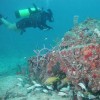Artificial reefs are constructed to provide several important ecosystem services to coastal communities and fisheries around the world, and their deployment results in significant socio-ecological and economic effects. To understand these effects, this document gives an overview of the agencies and people involved in the use of artificial reefs, how the implementation of these reefs influences their perception, and what issues are associated with their deployment. This document also specifically describes the process by which most artificial reefs are implemented in Florida.
https://edis.ifas.ufl.edu/fa231
Tag: Artificial Reefs
Guidelines and Management Practices for Artificial Reef Siting, Use, Construction, and Anchoring in Southeast Florida (TP176/SG101)
 Coral reefs are one of southeast Florida’s most highly valued ocean resources. Despite their economic and ecological importance, they continue to face damage and destruction from human activity. “Artificial reefs” can help restore damaged coral reefs or mitigate their loss. Hundreds these natural and man-made structures have been deployed in southeast Florida coastal waters over the last 30 years. However, construction practices, design features and use patterns associated with this reef-building all have the potential to affect coral ecosystems. This 162-page guide describes artificial reef science and technology as a means of helping practitioners with varied backgrounds, skills and experience achieve responsible and sustainable reef development. Written by William Lindberg and William Seaman, and published by the UF Florida Sea Grant Program, June 2012.
Coral reefs are one of southeast Florida’s most highly valued ocean resources. Despite their economic and ecological importance, they continue to face damage and destruction from human activity. “Artificial reefs” can help restore damaged coral reefs or mitigate their loss. Hundreds these natural and man-made structures have been deployed in southeast Florida coastal waters over the last 30 years. However, construction practices, design features and use patterns associated with this reef-building all have the potential to affect coral ecosystems. This 162-page guide describes artificial reef science and technology as a means of helping practitioners with varied backgrounds, skills and experience achieve responsible and sustainable reef development. Written by William Lindberg and William Seaman, and published by the UF Florida Sea Grant Program, June 2012.
http://edis.ifas.ufl.edu/sg101